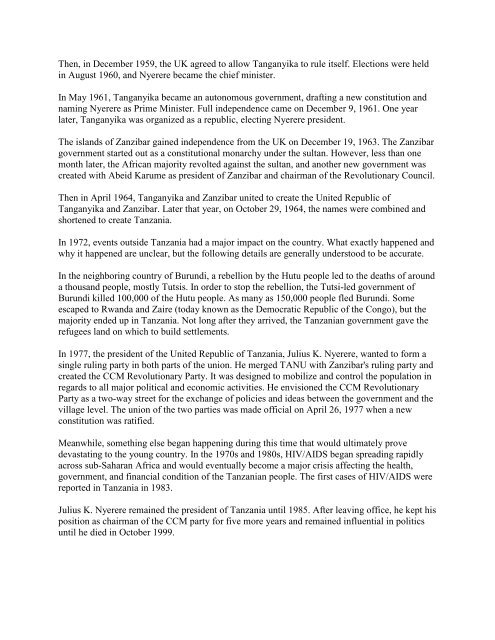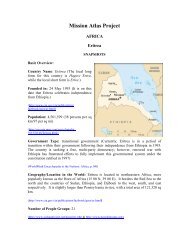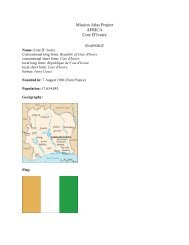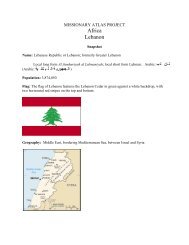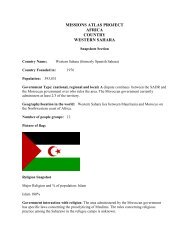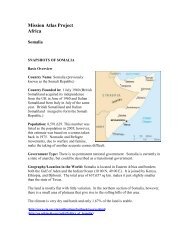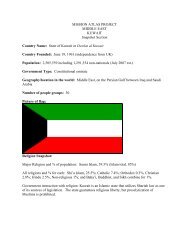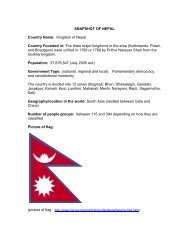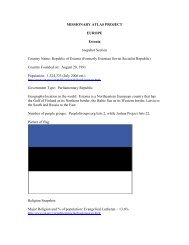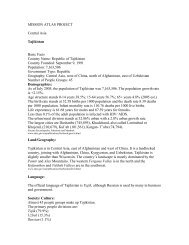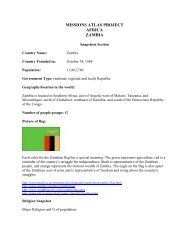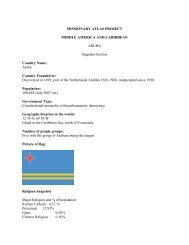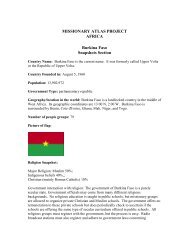Tanzania Profile.pdf - WorldMap
Tanzania Profile.pdf - WorldMap
Tanzania Profile.pdf - WorldMap
You also want an ePaper? Increase the reach of your titles
YUMPU automatically turns print PDFs into web optimized ePapers that Google loves.
Then, in December 1959, the UK agreed to allow Tanganyika to rule itself. Elections were heldin August 1960, and Nyerere became the chief minister.In May 1961, Tanganyika became an autonomous government, drafting a new constitution andnaming Nyerere as Prime Minister. Full independence came on December 9, 1961. One yearlater, Tanganyika was organized as a republic, electing Nyerere president.The islands of Zanzibar gained independence from the UK on December 19, 1963. The Zanzibargovernment started out as a constitutional monarchy under the sultan. However, less than onemonth later, the African majority revolted against the sultan, and another new government wascreated with Abeid Karume as president of Zanzibar and chairman of the Revolutionary Council.Then in April 1964, Tanganyika and Zanzibar united to create the United Republic ofTanganyika and Zanzibar. Later that year, on October 29, 1964, the names were combined andshortened to create <strong>Tanzania</strong>.In 1972, events outside <strong>Tanzania</strong> had a major impact on the country. What exactly happened andwhy it happened are unclear, but the following details are generally understood to be accurate.In the neighboring country of Burundi, a rebellion by the Hutu people led to the deaths of arounda thousand people, mostly Tutsis. In order to stop the rebellion, the Tutsi-led government ofBurundi killed 100,000 of the Hutu people. As many as 150,000 people fled Burundi. Someescaped to Rwanda and Zaire (today known as the Democratic Republic of the Congo), but themajority ended up in <strong>Tanzania</strong>. Not long after they arrived, the <strong>Tanzania</strong>n government gave therefugees land on which to build settlements.In 1977, the president of the United Republic of <strong>Tanzania</strong>, Julius K. Nyerere, wanted to form asingle ruling party in both parts of the union. He merged TANU with Zanzibar's ruling party andcreated the CCM Revolutionary Party. It was designed to mobilize and control the population inregards to all major political and economic activities. He envisioned the CCM RevolutionaryParty as a two-way street for the exchange of policies and ideas between the government and thevillage level. The union of the two parties was made official on April 26, 1977 when a newconstitution was ratified.Meanwhile, something else began happening during this time that would ultimately provedevastating to the young country. In the 1970s and 1980s, HIV/AIDS began spreading rapidlyacross sub-Saharan Africa and would eventually become a major crisis affecting the health,government, and financial condition of the <strong>Tanzania</strong>n people. The first cases of HIV/AIDS werereported in <strong>Tanzania</strong> in 1983.Julius K. Nyerere remained the president of <strong>Tanzania</strong> until 1985. After leaving office, he kept hisposition as chairman of the CCM party for five more years and remained influential in politicsuntil he died in October 1999.


